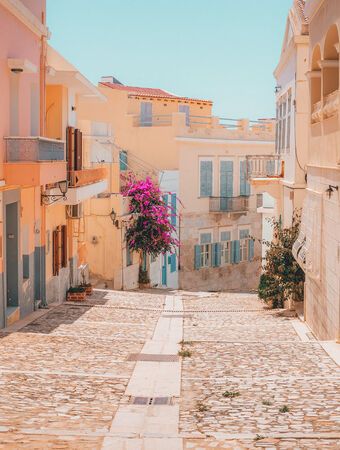The capital of the Cyclades, Syros is an island of many faces. Even its main town, built on two hills, has a dual identity. Ermoupoli (Hermes’ town) is stately and grand, topped by an Orthodox church. And above it, Ano (Upper) Syros is a typically Cycladic village that is crowned with Catholic monasteries and churches.
The contrasts blend attractively, from the marble-paved squares in the port to the fairy tale mansions of Dellagratsia. Syros is an island on which you could live all year round, so much is there to do. You’ll find it easy to fit into the daily life, where the traditional and the classic are as sweet as the island’s famous loukoumi (Turkish delight).
What to do on Syros island
Explore Ermoupoli, the queen of the Cyclades
You’ll never tire of this bustling yet regal port town. In the capital of Syros, marble flagstones pave its spacious main square, presided over by the grandiose Town Hall, one of the 19th-century masterpieces of Ernst Ziller, the famous Saxon architect who became a Greek national. Graceful, high-ceilinged neoclassical buildings emit an aura of earlier prosperity, among them the restored Apollo Theatre (a miniature of Milan’s La Scala), the Hellas Club, the Pallas cinema and many more perfect examples of the urban architecture of yesteryear. Their interiors are just as impressive, with wonderful woodwork and delightful murals.
Take a walking tour around Ermoupoli
Head to Vaporia, the Mayfair of Syros
sweeping views of the Mediterranean. Back in the 19th century, they were the scene of glamorous receptions and lavish balls for which Syros was famed. Below them, the dome of Agios Nikolaos Church stands out. Step inside to find an interior that reflects the wealth of its patrons: a marble icon screen and pulpit, and chandeliers brought all the way from Trieste. With a little luck, you may hear the church choir that has been sweetening the breeze since the 1920s.
Enjoy the beach, without even leaving town
At Ermoupoli’s beach, you can find everything: cafe-bars, shops, tavernas and restaurants, even a casino housed in a mansion dating back to the 1830s. At the end of the coastal road, you’ll find the old transit storerooms and an imposing 19th-century customs house.
See if you can resist the local sweets
They’re called loukoumia in Greek, Turkish delight in English, but these soft and chewy sweets, flavoured with rosewater, pistachios, almonds and the like are a true speciality of Syros. The locals say it’s their water - not the sugar or the flavourings - that make them so exquisite. You may find the sweets of Syros addictive, so don’t forget to take plenty with you when you leave. Try the nougat, too.
Explore Ano Syros and marvel at the view
Ano Syros has all the features of a typical Cycladic village. Its white cubist houses snuggle together on a steep hillside, linked by alleys barely wide enough for two people and occasionally opening up onto spectacular terraces. Two things make it unusual: the Renaissance Cathedral of St George on its summit and the monasteries below, and the bouzouki tunes of Markos Vamvakaris still heard in its shops and squares. A native son of Syros, Vamvakaris was one of the country’s finest rebetika (blues) musicians. From up here, you’ll have a panoramic view of Ermoupoli to rival any in the Cyclades.
Enjoy the best of wonderfully-preserved Ano Syros
Pick a favourite beach (and then pick another)
Remember these names: Galissas, Delfini, Kini, Finikas and Dellagratsia, where yesterday’s elite built their splendid villas. Their serene landscapes, sheltered waters and pretty coves are just right for a family holiday.
Hidden gems of Syros island
The Industrial Museum
Part of the former industrial district of Ermoupoli has been turned into a museum. Wander among its buildings and you’ll see permanent exhibits on shipping, industry and the history of Ermoupoli, which will add to your appreciation of Syros today.
The experience of Easter on Syros
Easter anywhere in Greece is by definition special, but Good Friday on Syros is particularly moving. All the town’s noble houses are illuminated, increasing the evening procession’s solemnity and heightening the sense that you have just stepped into the 19th century.
Grammata and the Grey Cave
Grammata means writing and at Grammata Bay in northern Syros, there are letters scratched onto the rocks. Generations of sailors, washed up on this inhospitable coast, inscribed their wishes, prayers and names on them. Most of them date from Roman and Byzantine times. You can reach the bay and the Grey Cave near it by boat or on foot.
🛌🏻 Where to stay in Syros
Find your accommodation with our list of hotels, villas and guest houses and book now to make your dream holiday in Syros a reality.
Syros ferry: schedules & tickets
Book your ferry tickets to Syros. You can travel by ferry from Athens to Syros all year long. There are regular crossings from the port of Piraeus (lasts approximately 2.5 hours) throughout the year. You can also travel directly to Syros from the port of Lavrion in Athens during the summer, as well as indirectly from the port of Rafina.







